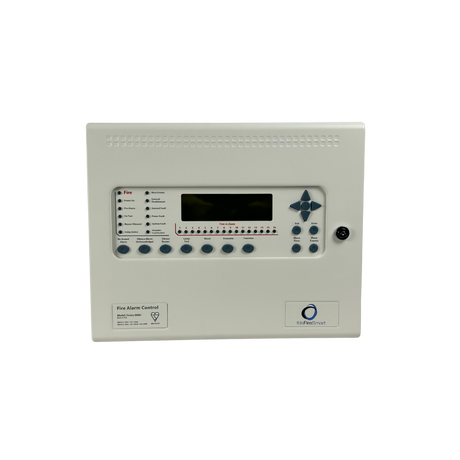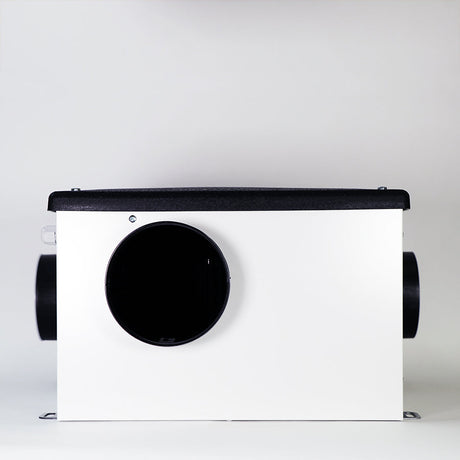Relevant UK Standards for Fans
This executive summary provides a concise overview of the key standards and regulations affecting the selection, commissioning, and maintenance of fans in the UK. It is designed for buyers, specifiers, and project managers who need a high-level reference without the technical depth of the full guidance document.
Note: This Technical guidance document is not exhaustive and covers common answers. Detailed or specific answers should be sought from professional consultants or building control prior to commencing installation, completing designs, or purchasing equipment.
Disclaimer: There are situations where consulting building control is necessary, particularly if a modification could compromise other building systems or affect the building’s compartmentation. We strongly advise that you consult professional advisors, as they will take a holistic view of the project and can determine whether contacting building control is required.
Furthermore, the information provided here is derived from open-source AI models, that may have inaccuracies, or manufacturers info and addresses simplified and generalised scenarios. There may be other standards which need to be considered and whilst we have produced technical bulletins these are for guidance purposes only and may not include all the standards that must be considered. We have to the best of our abilities looked to validate these statements and maintain them up to date. This information does not account for specific installation conditions or unique circumstances. We also cannot guarantee that this information has not been superseeded or that it is exhaustive for your particular use. Therefore, any prospective purchaser should always seek guidance from qualified professionals or building control authorities, especially when specific products or complex installations are involved, before placing an order.
1. Project Type – Which Standards Apply?
Residential (houses, flats, dwellings)
• BS EN 13141-2 – Manufacturer lab testing for MEV/MVHR units.
• Approved Document F – Ventilation requirements, with compliance testing on site.
• Domestic Ventilation Compliance Guide (DVCG) – Practical test methods.
Commercial / Industrial HVAC
• CIBSE Code A and BSRIA BG 49 – Site commissioning and balancing.
• BS EN 12599 and BS EN 16211 – Airflow measurement and balancing methods.
• BS EN ISO 5801 – Fan performance curves.
• BS EN ISO 12759 – Efficiency standards (Ecodesign/ErP compliance).
Smoke Control Systems
• BS 7346-5 – Code of practice for design, commissioning, maintenance.
• BS EN 12101-3 – Powered smoke and heat exhaust fans (temperature-rated).
• BS EN 12101-6 & BS EN 12101-8 – Pressure differential systems and dampers.
• Approved Document B – Fire safety compliance.
2. Key Considerations for All Buyers
Energy Efficiency
• Ecodesign Regulation 327/2011 – Minimum efficiency for fans ≥125 W.
• Approved Document L – Building energy performance.
Electrical & Safety
• BS EN 60204-1 – Electrical safety for machinery.
• BS EN 60335-2-80 – Domestic fan safety.
• BS EN 61439 – Control panels.
Acoustics
• BS EN ISO 13347 – Fan noise performance.
• CIBSE Guide B4 – Noise control in building services.
Certification
• UKCA/CE Marking – Mandatory conformity with LVD, EMC, and Ecodesign.
• Declaration of Performance (DoP) – Required for smoke fans.
3. What to Check in O&M Documentation
• Fan ID, duty, and manufacturer details.
• Airflow, pressure, electrical, and speed measurements.
• Final balanced settings of controls/dampers.
• Test results against design tolerances.
• Calibration certificates and commissioning sign-off.
• For smoke fans: fire rating certification, cause-and-effect testing, and ongoing test procedures.
4. At-a-Glance Compliance Flow
1) Identify project type → Residential / Commercial / Smoke.
2) Apply relevant performance standards → Site or lab testing.
3) Confirm efficiency & energy compliance → Ecodesign + Part L.
4) Check electrical, acoustic, and EMC requirements.
5) Ensure certification → UKCA/CE and DoP (smoke fans).
6) Record evidence in O&M for commissioning and future maintenance.
Relevant UK Standards & Guidance – Fans
Note: This Technical guidance document is not exhaustive and covers common answers. Detailed or specific answers should be sought from professional consultants or building control prior to commencing installation, completing designs, or purchasing equipment.
Summary Table of Key Standards
|
Standard / Regulation |
Scope |
When It Applies |
|
CIBSE Code A |
Commissioning code for air distribution systems |
All UK HVAC balancing & commissioning |
|
BSRIA BG 49/2013 |
Commissioning procedures & reporting formats |
All HVAC balancing projects |
|
BS EN 12599:2012 |
Testing, adjusting & balancing of building HVAC systems (site testing) |
All HVAC systems |
|
BS EN 16211:2015 |
On-site airflow measurement methods |
HVAC airflow testing |
|
BS EN ISO 5801 |
Fan performance testing (pressure/flow curves) |
Manufacturers & verification of performance |
|
BS EN ISO 12759 |
Energy efficiency of fans |
All fans ≥125 W under Ecodesign (ErP) |
|
Ecodesign Regulation 327/2011 |
Minimum efficiency for fans (retained UK law) |
Industrial & commercial fans |
|
BS EN ISO 13347 |
Acoustics – Fan sound power level testing |
Projects with noise limits / environmental requirements |
|
BS EN 60335-2-80 |
Household/similar electrical fans safety |
Residential/domestic fans |
|
BS EN 60204-1 |
Electrical safety of machinery |
Packaged fan systems with controls |
|
BS EN 61000 series |
Electromagnetic compatibility |
All electrically powered fans |
|
BS EN 61439 |
Low-voltage controlgear assemblies |
Fan control panels |
|
BS EN 13141-2 |
Residential ventilation units – lab performance testing |
MEV/MVHR units in housing |
|
Approved Document F |
Ventilation requirements for dwellings |
Domestic projects (compliance testing) |
|
Approved Document L |
Conservation of fuel and power |
Energy efficiency of building systems |
|
BS 7346-5:2005 |
Smoke and heat exhaust ventilation – design, commissioning, maintenance |
Smoke control systems |
|
BS EN 12101-3:2015 |
Powered smoke & heat exhaust ventilators (axial fans, F200–F600) |
Smoke control fans |
|
BS EN 12101-6:2005 |
Pressure differential systems |
Smoke control (escape routes) |
|
BS EN 12101-8:2011 |
Smoke control dampers |
Smoke ventilation designs |
|
Approved Document B |
Fire safety |
All building projects (fire-related systems) |
|
UKCA / CE Marking |
Conformity assessment under LVD, EMC, ErP |
All fans sold in UK/EU |
Quick Decision Guide – Which Standards Apply?
• Residential (houses, flats, dwellings) → Check BS EN 13141-2, Approved Document F, Domestic Ventilation Compliance Guide. Ensure manufacturer certification is in O&M.
• Commercial / Industrial HVAC → Check CIBSE Code A, BSRIA BG 49, BS EN 12599/16211 for site balancing, plus BS EN ISO 5801 and ISO 12759.
• Smoke Control Systems → Must comply with BS 7346-5 and BS EN 12101 series. Ensure fire rating certification (F200–F600).
Key considerations: Energy (Ecodesign + Part L), Acoustics (BS EN ISO 13347, CIBSE B4), Electrical (BS EN 60204-1 / 60335-2-80 / 61439), EMC (BS EN 61000), Certification (UKCA/CE, DoP for smoke fans).
Most Common Standards
CIBSE (Chartered Institution of Building Services Engineers)
• CIBSE Commissioning Codes (notably Code A: Air Distribution Systems) – the core UK reference for air system balancing.
• CIBSE Guide M (Maintenance Engineering & Management) – guidance on what evidence should be retained in O&M manuals.
BSRIA (Building Services Research and Information Association)
• BG 49/2013 Commissioning Air Systems (and earlier Application Guides like AG 3/2002.2).
• Standard pro formas and reporting formats for recording balancing results.
BS/EN Standards (Site Testing & Balancing)
• BS EN 12599:2012 – Testing, adjusting and balancing of building HVAC systems.
• BS EN 16211:2015 – Ventilation for buildings — Measurement of air flow on site.
What Evidence Should Be Recorded in O&M (UK Context)
1. System & Fan Information
• Fan ID, location, duty (design volume flow rate, pressure, speed, power).
• Manufacturer, model, serial number.
• Method of control (e.g., VSD, damper, blade pitch).
2. Measurement & Balancing Data
• Airflow measurements at each relevant terminal or duct section (using recognised UK methods – pitot traverse, anemometer, etc.).
• Static & total pressures across the fan/system.
• Fan speed (RPM) as set.
• Electrical readings: volts, amps, kW.
• System resistance (inferred from pressure measurements vs fan curve).
3. Adjustment Records
• Description of balancing actions (damper positions, VSD settings, pitch adjustments).
• Final locked settings of dampers or controls.
4. Compliance with Design
• Design vs measured vs final airflow for each section/terminal.
• Tolerances in line with CIBSE Code A (generally ±10% of design airflow for terminals, unless otherwise specified).
• Statement of whether system meets design intent.
5. Certification & Verification
• Date, engineer/commissioning specialist name, company, and qualifications.
• Instruments used with calibration details (certificate number & date).
• Witness sign-off (client/consultant).
6. Supporting Evidence
• Tabulated test sheets (BSRIA forms are commonly used).
• Annotated drawings or schematics showing measurement points and damper settings.
• Any building management system (BMS) trend logs if airflow is monitored electronically.
In summary (UK only): For axial fans, O&M evidence of airflow balancing should include measured vs design airflow and pressure data, balancing adjustments, final operating settings, calibration details, and sign-off, all in accordance with CIBSE Commissioning Code A, BSRIA BG 49/2013, and BS EN 12599.
UK Standards for Smoke Control Systems (including axial fans used for smoke extract)
Smoke control systems (fans, dampers, shafts, etc.) are treated differently in the UK compared to comfort ventilation or general HVAC, because they are life safety systems.
While CIBSE Code A, BSRIA BG 49, and BS EN 12599 apply to normal HVAC balancing, smoke control systems must comply with additional fire and life safety standards.
• BS 7346 series – Components for smoke and heat control systems
- BS 7346-5:2005 – Code of practice for design, installation, commissioning and maintenance of smoke and heat exhaust ventilation systems.
• BS EN 12101 series – Smoke and heat control systems
- BS EN 12101-3:2015 – Specification for powered smoke and heat exhaust ventilators (axial fans, elevated temperature ratings e.g., F200, F300, F400, F600).
- BS EN 12101-6:2005 – Pressure differential systems (PDS).
- BS EN 12101-8:2011 – Smoke control dampers.
Building Regulations & Guidance (Smoke Control)
• Approved Document B (ADB) – England
• Technical Handbook (Fire) – Scotland
• Approved Document B – Wales
• Technical Booklet E – Northern Ireland
In short: For general HVAC fans, balancing evidence follows CIBSE Code A / BSRIA / BS EN 12599. For smoke control axial fans, you must also provide evidence to BS 7346-5 and BS EN 12101-3, including certification of fire rating, commissioning of smoke control mode, cause-and-effect testing, and ongoing maintenance records.
Evidence to Record in O&M for Smoke Control Fans (UK)
In addition to normal balancing evidence (airflow, pressure, speed, calibration, etc.), O&M must include:
1. Certification & Compliance
• UKCA/CE marking & BS EN 12101-3 certification of the fan.
• Temperature and time rating (e.g., F300 2h).
• Declaration of Performance (DoP).
2. Commissioning & Testing Records
• As-tested airflow & pressure under both normal and smoke mode (if dual-purpose).
• Fan start-up verification from all smoke/fire control inputs.
• Response time and confirmation of correct sequencing with dampers/louvres.
• Emergency power supply test (generator/UPS changeover).
• Fail-safe positions of dampers and shutters verified.
• Controls integration test (fire alarm interface, cause-and-effect matrix).
3. Maintenance & Ongoing Test Records
• Routine test procedures (weekly/monthly functional tests, annual full tests).
• Requirements for periodic airflow verification (to confirm no obstruction of shafts/ducts).
• Vibration and bearing checks (critical under high temperature operation).
4. O&M Documentation Standards
• CIBSE Guide M (maintenance), supplemented with BS 7346-5 requirements.
• Clear distinction between “normal mode” operation and “smoke mode” operation in test results.
Additional Relevant Standards & Regulations
Performance & Efficiency
• BS EN ISO 5801 – Performance testing of fans (establishes fan pressure/flow curves).
• BS EN ISO 12759 series – Energy efficiency of fans (ties into Ecodesign/ErP).
• Ecodesign Regulation (EU) 327/2011 – Minimum efficiency requirements for fans (125 W–500 kW). Retained in UK law.
• Approved Document L (Conservation of Fuel and Power) – Requires efficient systems.
Safety & Electrical
• BS EN 60204-1 – Safety of machinery – Electrical equipment of machines (packaged systems).
• BS EN 60335-2-80 – Household/similar electrical appliances – Particular requirements for fans.
• BS EN 61000 series – Electromagnetic compatibility (EMC).
• BS EN 61439 – Low-voltage switchgear and controlgear assemblies (for control panels).
Acoustics
• BS EN ISO 13347 series – Acoustics – Determination of fan sound power levels.
• CIBSE Guide B4 – Noise control for building services.
Residential / Domestic Ventilation
• BS EN 13141 series – Performance testing of residential ventilation components:
- Part 2: Exhaust and supply units (lab test for airflow, pressure, power, acoustics).
- Other parts cover terminals, duct components, cowls, etc.
• Approved Document F (Ventilation) – Includes Domestic Ventilation Compliance Guide (DVCG) requirements for installed systems.
• For residential MEV/MVHR, O&M should retain manufacturer’s BS EN 13141 test certificates.
Certification & Marking
• UKCA marking (or CE, if relevant) – Required conformity with LVD, EMC, and Ecodesign.
• Declaration of Performance (DoP) – Particularly for smoke fans under BS EN 12101-3.
Practical Application for Buyers
• Industrial/Commercial HVAC Fans – Check compliance with BS EN ISO 5801 (performance), ISO 12759 (efficiency), acoustics standards, and UKCA/CE marking.
• Residential Packaged Fans (MEV/MVHR) – Ensure manufacturer has BS EN 13141-2 certification, and retain this in O&M. Site testing to Part F required.
• Smoke Control Fans – Must meet BS 7346-5 and BS EN 12101-3, with fire rating certification and commissioning in smoke mode.
• Controls/Panel Systems – Must meet BS EN 60204, BS EN 61439, and EMC testing.
• Energy Compliance – All fans must comply with Ecodesign (ErP) efficiency requirements.
How BS EN 13141-2 Relates
• BS EN 13141-2:2021 – Ventilation for buildings – Performance testing of components/products for residential ventilation – Part 2: Exhaust and supply ventilation units.
• Scope: Applies mainly to residential mechanical ventilation units (including fans, filters, heat exchangers). Sets laboratory methods for airflow, pressure, leakage, electrical power, acoustics, etc., under standardised conditions.
• Relation to Balancing & O&M: It is a type-testing standard (manufacturer’s lab testing), not a site testing/balancing standard. On site, installers verify performance against Approved Document F; they do not repeat BS EN 13141-2 tests.
• Applicability: For domestic MEV/MVHR units. General commercial axial fans and smoke extract fans fall under commissioning and smoke control standards (BS EN 12599, CIBSE/BSRIA, BS EN 12101-3, BS 7346-5).
• Practical note: O&M should retain the manufacturer’s 13141-2 performance declaration alongside site test results for residential projects.





